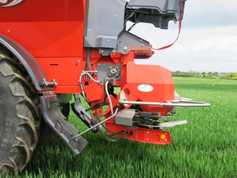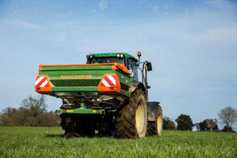It was always going to happen: a fairytale January weather-wise ended on a sour note and February hasn’t been much better. Grazing plans have been kicked to touch for the most part. With good winter growth rates – up to 5kg DM/ha daily in some parts – there is grass in some form on most farms at this point.
![]()
Now, the big determinant of turnout date is the rate at which soils can dry out. For the next five to six days, the small amount of rain that is forecast looks to be heading to the southern part of the country, which will offer some reprieve to those on wetter ground in the midlands.
Spring grazing is a contentious issue for many, but it needn’t be. Grazing days in spring are the most lucrative of all. Every day at grass in the spring represents a saving of €2.70 per head. While an obvious drawback, there is still a place for it on heavy-soiled farms.

It might look unsightly, but poaching damage to the top centimetres of a field – the depth of your little finger – will recover quite quickly. For me, there are three things to remember when grazing a potentially wet piece of ground, concerning the field itself, the animal and the weather:
The field should be split up – give the animals a small allocation and keep them moving. You’ll likely get one chance to eat the grass there and ideally cattle shouldn’t get more than a day’s worth of grazing area.
For 20 500kg animals going into an 8cm cover, that’s around a quarter hectare (or three quarters of an acre). If given a bigger area they’ll do laps – damaging the ground and wasting grass.
The animals should be hungry going to grass. If they’re coming from a dry paddock to a wet one, make them eat the dry one sub-4cm. This will ensure that what’s there next time round is of the utmost quality and build up an appetite for when they hit the wet paddock. Heads will be down immediately and walking damage minimised.
The weather is the last point: don’t let animals onto wet ground in the rain. They’ll go for laps and then congregate in one corner, writing the area off for a few rotations. If infrastructure permits, stand them in a yard or on a farm roadway for a few hours until the rain stops.

David Mitchell, Co Monaghan
The ground around here is quite soft at the moment. While it wasn’t too bad over the weekend, we got a nice drop of rain on Monday. I’m not under massive pressure to get slurry out, but having said that I’d like to get 1,500-2,000 gallons spread on my lighter covers by this time next week.
The demand from the sheep flock makes spring grazing hard to manage at times, but I have planned ahead and there are a couple of fields around the yard with good covers of grass.
If ground allows, I’ll go out with light yearling heifers next week. There are good lie-back facilities in my sheds and I’m managing fine with calves and cows indoors at present. My calving pattern is split between spring and autumn.
Obviously, I don’t want the spring calves to be inside for too long when they arrive – five have come so far and I expect another five in the next week. But for me if they’re going out they won’t come back in, so I want to be sure.

Billy Glasheen, Co Tipperary
I took the opportunity with the recent dry weather to get out slurry. I spread 2,000 gallons on all the silage ground and some paddocks with light covers. Once the weather picks up again I plan to go with a blanket spread of half a bag of urea over the whole farm.
Weather permitting, my target is to start letting out light stores from mid-February, once I have my herd test completed. The last of my slaughter cattle go early next week. They were housed at the end of October.
This winter I only finished half the number I normally finish because current factory prices barely cover feed costs. I only finished cattle that would have been too heavy to go back to grass.
My closing covers were 500kg DM/ha, I will begin measuring again this week and expect an average cover of 750-800kg DM/ha. The results of my silage analysis completed last October indicated all 70%-plus DMD silage. Though I did not weigh my store cattle yet, they look to have done well over the winter.

Mark Maxwell, Co Westmeath
My average farm cover at present is 844kg DM/ha, which I am happy with. In the coming days I’ll be spreading CAN across the farm, avoiding the heavy covers (>10cm), which will get a tight grazing and likely a blast of slurry. I was able to get slurry out on 20 January and can see a great response already.
My soil thermometer showed 6oC last week – the threshold for grass growth. While the weather was good on Tuesday and yesterday, a lot of rain fell on Monday.
In truth, the last fortnight has been quite wet around these parts, so ground conditions are not ideal. It has slightly hampered my plans for getting cattle out. I had hoped to let cattle out before last weekend, but decided otherwise.
There looks to be a decent spell coming now, which I might capitalise on.
The first animals to go to grass will be my store cattle. They’ll come fit for slaughter at grass in May/June this year. I need to get them onto a spring grass diet as soon as I can.

I have no fertiliser out yet. Hindsight is a great thing, but January would have been ideal for it – soil temperatures are at 6.5°C currently. That said, I got just shy of 1,500 gallons of slurry onto my lighter covers in recent weeks, without a mark on the ground. It’s the earliest I can remember getting slurry out.
The winter has been a great one for me on the animal side. My shed has a creep facility and my 45 autumn calves have been going out as they please all winter. It’s a great way of training them to graze too. They enter covers around 6-7cm and graze to around 4cm. These paddocks have gotten slurry since.
I am in the middle of spring calving, with 20 dropped so far. Here, cows and calves go out for the first 10 days to harden up. Sometimes it’s a dangerous strategy, but conditions are ideal for it at present. Though it’s cold, at around 0oC, conditions are settled. It’s healthy weather.
Additional reporting by Matthew Halpin.
Read more
Grass+ dairy: a good forecast for early grazing
It was always going to happen: a fairytale January weather-wise ended on a sour note and February hasn’t been much better. Grazing plans have been kicked to touch for the most part. With good winter growth rates – up to 5kg DM/ha daily in some parts – there is grass in some form on most farms at this point.
![]()
Now, the big determinant of turnout date is the rate at which soils can dry out. For the next five to six days, the small amount of rain that is forecast looks to be heading to the southern part of the country, which will offer some reprieve to those on wetter ground in the midlands.
Spring grazing is a contentious issue for many, but it needn’t be. Grazing days in spring are the most lucrative of all. Every day at grass in the spring represents a saving of €2.70 per head. While an obvious drawback, there is still a place for it on heavy-soiled farms.

It might look unsightly, but poaching damage to the top centimetres of a field – the depth of your little finger – will recover quite quickly. For me, there are three things to remember when grazing a potentially wet piece of ground, concerning the field itself, the animal and the weather:
The field should be split up – give the animals a small allocation and keep them moving. You’ll likely get one chance to eat the grass there and ideally cattle shouldn’t get more than a day’s worth of grazing area.
For 20 500kg animals going into an 8cm cover, that’s around a quarter hectare (or three quarters of an acre). If given a bigger area they’ll do laps – damaging the ground and wasting grass.
The animals should be hungry going to grass. If they’re coming from a dry paddock to a wet one, make them eat the dry one sub-4cm. This will ensure that what’s there next time round is of the utmost quality and build up an appetite for when they hit the wet paddock. Heads will be down immediately and walking damage minimised.
The weather is the last point: don’t let animals onto wet ground in the rain. They’ll go for laps and then congregate in one corner, writing the area off for a few rotations. If infrastructure permits, stand them in a yard or on a farm roadway for a few hours until the rain stops.

David Mitchell, Co Monaghan
The ground around here is quite soft at the moment. While it wasn’t too bad over the weekend, we got a nice drop of rain on Monday. I’m not under massive pressure to get slurry out, but having said that I’d like to get 1,500-2,000 gallons spread on my lighter covers by this time next week.
The demand from the sheep flock makes spring grazing hard to manage at times, but I have planned ahead and there are a couple of fields around the yard with good covers of grass.
If ground allows, I’ll go out with light yearling heifers next week. There are good lie-back facilities in my sheds and I’m managing fine with calves and cows indoors at present. My calving pattern is split between spring and autumn.
Obviously, I don’t want the spring calves to be inside for too long when they arrive – five have come so far and I expect another five in the next week. But for me if they’re going out they won’t come back in, so I want to be sure.

Billy Glasheen, Co Tipperary
I took the opportunity with the recent dry weather to get out slurry. I spread 2,000 gallons on all the silage ground and some paddocks with light covers. Once the weather picks up again I plan to go with a blanket spread of half a bag of urea over the whole farm.
Weather permitting, my target is to start letting out light stores from mid-February, once I have my herd test completed. The last of my slaughter cattle go early next week. They were housed at the end of October.
This winter I only finished half the number I normally finish because current factory prices barely cover feed costs. I only finished cattle that would have been too heavy to go back to grass.
My closing covers were 500kg DM/ha, I will begin measuring again this week and expect an average cover of 750-800kg DM/ha. The results of my silage analysis completed last October indicated all 70%-plus DMD silage. Though I did not weigh my store cattle yet, they look to have done well over the winter.

Mark Maxwell, Co Westmeath
My average farm cover at present is 844kg DM/ha, which I am happy with. In the coming days I’ll be spreading CAN across the farm, avoiding the heavy covers (>10cm), which will get a tight grazing and likely a blast of slurry. I was able to get slurry out on 20 January and can see a great response already.
My soil thermometer showed 6oC last week – the threshold for grass growth. While the weather was good on Tuesday and yesterday, a lot of rain fell on Monday.
In truth, the last fortnight has been quite wet around these parts, so ground conditions are not ideal. It has slightly hampered my plans for getting cattle out. I had hoped to let cattle out before last weekend, but decided otherwise.
There looks to be a decent spell coming now, which I might capitalise on.
The first animals to go to grass will be my store cattle. They’ll come fit for slaughter at grass in May/June this year. I need to get them onto a spring grass diet as soon as I can.

I have no fertiliser out yet. Hindsight is a great thing, but January would have been ideal for it – soil temperatures are at 6.5°C currently. That said, I got just shy of 1,500 gallons of slurry onto my lighter covers in recent weeks, without a mark on the ground. It’s the earliest I can remember getting slurry out.
The winter has been a great one for me on the animal side. My shed has a creep facility and my 45 autumn calves have been going out as they please all winter. It’s a great way of training them to graze too. They enter covers around 6-7cm and graze to around 4cm. These paddocks have gotten slurry since.
I am in the middle of spring calving, with 20 dropped so far. Here, cows and calves go out for the first 10 days to harden up. Sometimes it’s a dangerous strategy, but conditions are ideal for it at present. Though it’s cold, at around 0oC, conditions are settled. It’s healthy weather.
Additional reporting by Matthew Halpin.
Read more
Grass+ dairy: a good forecast for early grazing











 This is a subscriber-only article
This is a subscriber-only article
















SHARING OPTIONS: